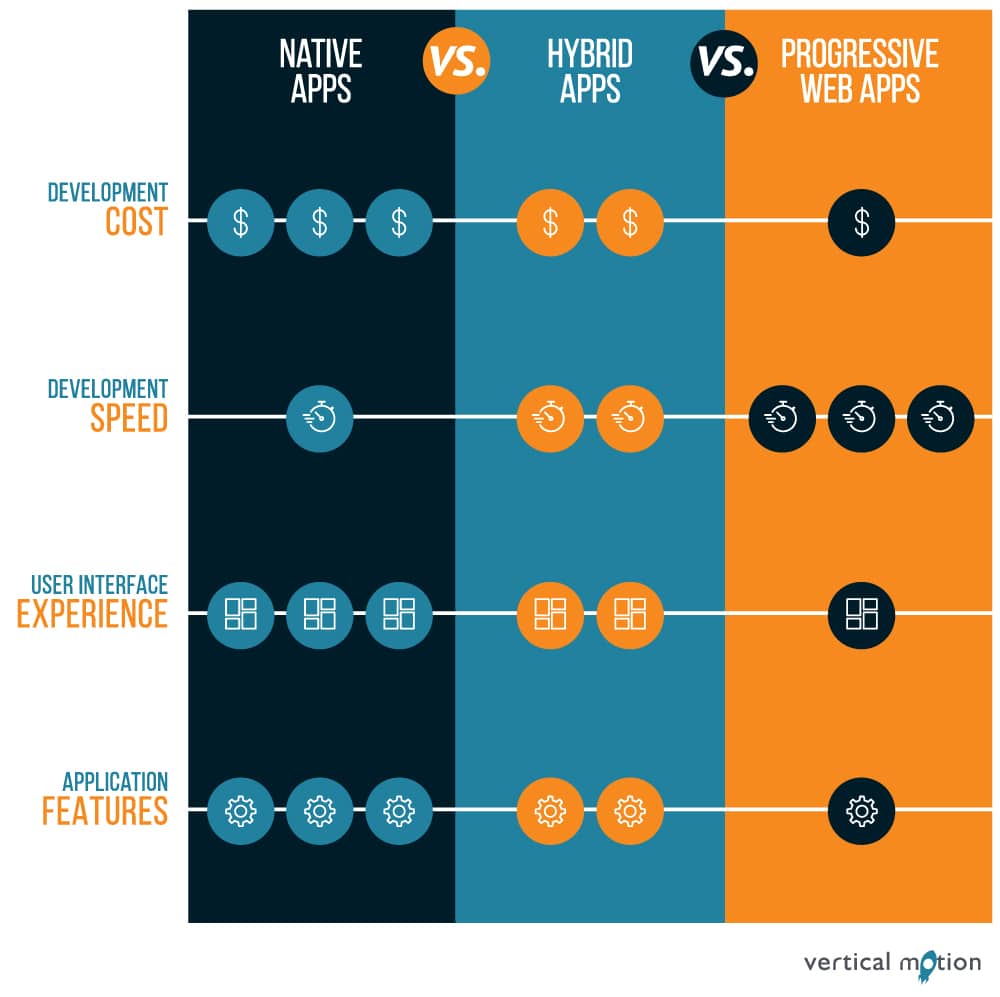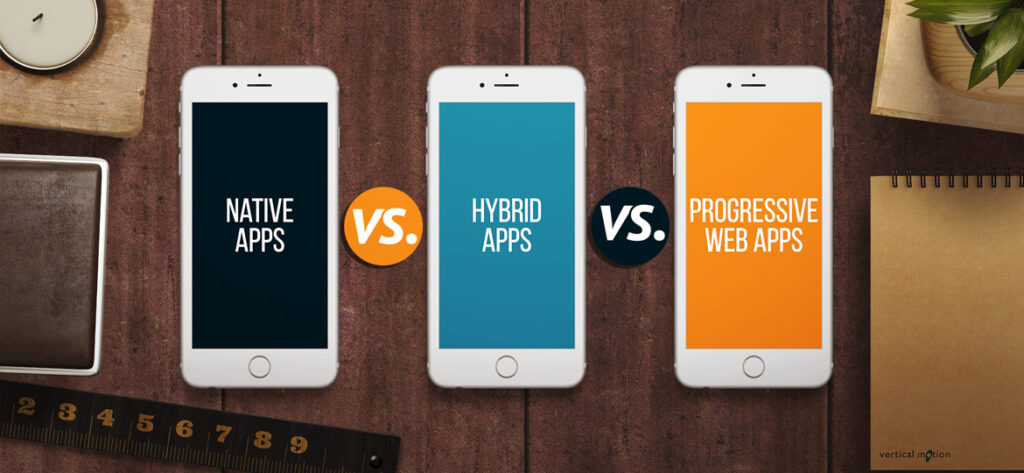Native Apps vs. Hybrid Apps vs. Progressive Web Apps
Isn’t it incredible what we can do on smart devices in 2021? From ordering food on Uber Eats to scrolling through photos on Instagram, the world is truly at our fingertips. Despite the beautiful user interface (UI) and seamless user experience (UX), not all apps are built alike. Although you can rarely tell as a consumer, these choices on what type of app to build is important for the businesses that run them. In early September, we posted a practical guide on the differences between native, hybrid, and progressive web apps in a simple-to-use mobile app infographic. But, many of you reached out wanting to know more about the differences, benefits, and drawbacks between the three. So we caught up with three Vertical Motion members to talk tech and dive deeper into mobile application development.
Our Tech Talent
Kyle Anderson has been with Vertical Motion Inc. for a little under two years now. He is a full-stack developer specializing in PWAs, WordPress, and now expanding his work into native applications. With over 23 years in Information & Communications Technology, Kyle has extensive experience in budgeting & managing the design and development of online solutions for clients in a broad range of businesses and organizations.
Pablo Cafiso has been with Vertical Motion Inc. for almost a year, working as a senior developer specializing in back-end development. Pablo is an expert in 15 different programming languages and technologies including JavaScript, HTML, Azure, & Unity. He also brings with him over 24 years of programming experience and is a Microsoft Certified Professional.
Jason Jones, the president of Vertical Motion Inc., founded the company in 2006. His extensive business background includes a diverse client portfolio Dell, HP, Bell, Canadian Pacific Railway, Shell, and Shaw Communications inc. Jason is also an Entrepreneur in Residence (EiR) at Foresight Canada and a Business Mentor at Futurepreneur Canada.

A quick overview of Cost, Speed, Experience, and Features depending on which kind of mobile application you choose.

Let’s Talk Mobile Apps
How has mobile app technology and mobile app development changed since it first started?
Jason Jones (JJ): When mobile devices first came out, they were seen as entertainment devices. It wasn’t seen as a device for businesses until about a year after they launched. In the beginning, there was a lot of excitement around the technology and the collection of information. But, the industry quickly realized that they needed to gain control of their innovation and implement security measures to keep information private. It was also a big step in businesses going paperless which led to greater internal efficiency. Going digital made a lot of issues more visible along the supply chain from manufacturing to the end customer. However, there was a big learning curve and many mistakes made by Apple and Android along the way. However, it allowed for greater access to resources that wouldn’t have been feasible for many small businesses earlier.
Pablo Cafiso (PC): Back when the first applications were built for Blackberry devices, they were very rudimentary. Essentially, the application was a basic replica of your website scaled to the size of your phone screen. It allowed users to quickly glance at information on the go, and make changes later on their office computer later. Now in 2021, mobile applications have far exceeded early expectations. The enhanced functionality and user experience gives you the ability to do almost as much as you can on the computer.
Kyle Anderson (KA): A big change in mobile development from my perspective is the way applications are developed now. Originally, developers had to build individual applications for iOS and Android, which would both have to be separate from your website. With the development of more sophisticated technology, our jobs have gotten much easier. Client costs have also dropped as developers can now build one application and use technology to convert it to each platform.
What are some key factors that businesses need to consider before building a mobile application?
JJ: The most important thing to consider is why do you want an application? What is the problem you are trying to solve? Mobile technology first and foremost is a solution, a tool, and a component. So the first step is identifying what the problem is you’re trying to solve and then applying a solution to it. It could be mobile, web, pen and paper, rolling a stone down a hill, or whatever it is that will solve the problem most effectively. But, don’t get fixated on mobile. It’s just one of the options out there. Figure out the problem first, then figure out the solution.
PC: First, businesses need to consider what the purpose of the application is. If the application is going to be used internally on company devices, then you may only need to build an application for one platform. This allows for greater app functionality and speed based on the tools we use. Alternatively, if the application needs to be accessible on different platforms, then businesses need to consider the purpose of their application as it will dictate the way the app will be built and how much it will cost.

Native Applications
What can you tell our readers about native mobile application development?
JJ: Native applications tend to be positioned towards more high-end features and a greater reliance on memory usage. This translates into a lot more development time associated with it and the cost tends to be higher. Native applications rely heavily on the device itself as well as the functionality and feature set within that device. For example, if you want to use biometric authentication such as a fingerprint scanner or face ID, it is much easier to accomplish this through a native application compared to other apps. Common examples of native apps include WhatsApp, Waze, and Pokémon Go.
PC: Just as Jason mentioned, native apps are built specifically to take full advantage of the hardware they run on, whether that be Android or Apple. Because of this, you are unable to take an application that is built for Android in the language that it uses and try to run it on Apple. It just doesn’t work. As a result, if you need to build a multi-platform app, but need to access the full functionality of the device, then you will need to build multiple versions of the application.
KA: To add to that, depending on the complexity of your app and the amount of user interaction such as clicking and inputting data, a native app offers a noticeably better interface and faster speed too. Really it comes down to the size of your company, the resources you have, and the budget available.
Hybrid Applications
What can you tell our readers about hybrid mobile application development?
JJ: Hybrid-based solutions are primarily focused on building the application code once and then sharing it across multiple platforms. This could be done through a number of tools, including using a platform that can develop the code for both iOS and Android-based on the platform’s code you write with. However, because you are using a third language to create the two application versions, it has its limitations. You will not be able to capture all the visual controls such as menus, buttons, displays and layouts as you would with a native build. Instead, the hybrid model allows you to get the best of both worlds by developing a consistent layout across both platforms at a lower cost than developing each app individually through a native build. Common examples of hybrid apps include Gmail, Instagram, and the Amazon App Store.
KA: On the application development side, hybrid applications are faster and cheaper to develop, while also being easier to maintain. We build hybrid apps, as Jason, said, with a tool that allows you to build the application once and deploy it on multiple platforms.
PC: To add to that, for commercial applications designed for everyday use a hybrid application is much more cost-effective for businesses. Not only in the development stage but also in maintaining the application.
Progressive Web Applications (PWA)
What can you tell our readers about progressive web application development?
JJ: Progressive Web Applications (PWA) are a fairly new approach to application development. They are a way to avoid the hassle of the iOS and Android approval process. Put simply, anything you can do on a web browser, you can do on a PWA. That being said, the app is dependent on the web browser on the mobile device. As a result, it is inherently limited in what it can access on the device. This includes the amount of storage, the inability to access biometric features, as well as push notifications on iOS devices. Common examples of PWAs include Starbucks, Forbes, and Flipboard.
PC: In terms of cost, PWAs are the least expensive with respect to the other applications discussed today. This is mostly due to the simplicity of the development.
KA: The biggest difference between PWAs and other applications is that users in many cases don’t go to the app store to download it. A common example is when you are on a webpage and asked if you want to install the application, and it installs it onto your device, which looks just like any other app on your home screen.

Going Forward
If someone has an app idea or wants to have an app built for their business, where should they start?
JJ: Start by figuring out what the problem is and then identify what the most optimal solution will be. Next, start thinking about the user journey. Whether you map this out on paper, Excel, Word or the back of a napkin, write out the user experience. What screens will they see? What type of data will they be able to collect? Who are the users that will be using this application? By having these details out of your head and onto something tangible, it makes it easier to know what has to be built and what solution is right for you.
Want to Stay Connected?
Vertical Motion Inc. is a Calgary & Kelowna based software and mobile development firm, creating customized solutions for Canadian businesses since 2006. Our team of expert business specialists, back-end developers, UI/UX designers, graphic designers, and coaches support the needs of all industries including health care, cleantech, energy, transportation, education, & fintech. We have experience in creating customized Web, iPhone, Android, and Windows business solutions for businesses of all sizes including startups, small businesses, not-for-profit organizations, and large corporations. Ready to take your idea to new heights? Drop us a line
Not quite ready yet? Sign up for our monthly newsletter for relevant business articles, Vertical Motion blogs, and our business Q & A. Have no fear we are spam clear! 🚀

Written By Tyler Mikitka, communications officer on the bridge at Vertical Motion.

